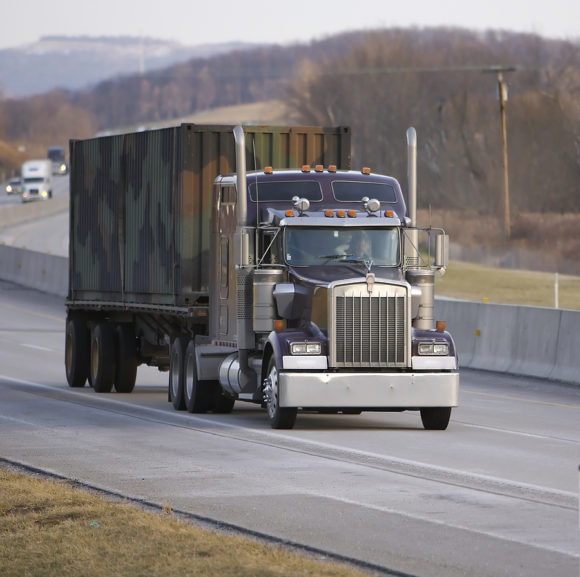Commercial motor carriers that committed to a strong safety culture and installed advanced safety technology were able to reduce vehicle crashes by as much as 75%, according to a new study by researchers with the Virginia Tech Transportation Institute.
The research team examined strategies used by nine trucking companies that had made significant improvements after being classified as “high risk” by the Federal Motor Carrier Safety Administration.
All of the carriers employed multiple strategies to improve safety, but two stood out as especially effective:
- Instilling a “safety culture” through steps such as holding regular safety meetings and encouraging employee input.
- Installing the latest safety technology such as automatic emergency braking and lane departure warnings.
“Six of the nine said technology was critically important,” said lead researcher Matthew Camden with Virginia Tech. “These technologies are improving every year and the companies are realizing the potential savings.”
Travelers and the National Safety Council supported the study. The researchers worked with insurance agencies and state trucking associations to find carriers that had improved their safety performance. The largest motor carrier selected had more than 1,000 trucks on the road; the smallest fewer than 50.
The case studies in the report measure the success of the safety measures implemented by each carrier by different standards, depending on each organization’s objectives. For example, a company identified as Carrier C targeted reductions in preventable crashes and achieved a 75.6% reduction from 2013 to 2018. Carrier D took aim at reducing its unsafe driving score, which is a number assigned to a fleet according to the number of violations of federal standards and the severity of those violations. Carrier D achieved a 45% improvement from 2012 to 2018.
The study’s findings are especially salient considering that the rate of fatal crashes increased 10% from 2016 to 2017.
According to the Federal Motor Carrier Safety Administration, the fatal crash rate for large trucks and buses jumped to 0.156 per 100 million miles driven in 2017, from 0.146 in the prior year. The FMCSA data shows that 4,889 trucks and buses were involved in fatal crashes in 2017, up from 4,485 the year before. A total of 5,005 people were killed in 2017. The number of deaths has not been that high since 2007.
Some safety advocates say that a proposal by the FMCSA to make its maximum driving-time rules more flexible threatens to deteriorate the safety record even further. The agency’s rule proposal would allow drivers who are on duty but not driving, such as when waiting for their truck to be unloaded, to count that time toward the 30-minute break that is required after eight hours of driving. Drivers are allowed to operate their vehicles up to 11 hours a day.
The Virginia Tech study found that improving driver scheduling to reduce fatigue was one of the measures that motor carriers used to improve safety. Improving hiring guidelines and vehicle maintenance were also in their safety aresnals.
Six of the nine carriers that improved their safety records said they made building a strong safety culture a part of the strategy. Camden said in a strong safety culture, employees feel that the employer cares and wants to hear his or her concerns. Some of the companies invited family members to company events so they can understand what a truck driver goes through, and understand the importance of getting a good night’s sleep.
Improving safety culture involved number of strategies. One trucking company installed software that allowed dispatchers to see drivers’ hours in real time so they could reschedule delivery appointments if needed and avoid pushing drivers to the limits of highway safety regulations. The same company also implemented a safety bonus program that increased pay to drivers who had no moving violations and passed all inspections.
Camden said his research time didn’t find any safety measures that were ineffective, with one possible exception. In the early years of the study, carriers that installed early versions of emergency braking systems did not see much return on their investment. Camden said when first introduced, the technology tended to catch signals from guardrails or other objects and alerted drivers to phantom perils. Later versions of the technology vastly improved performance.
Safety bonuses also got mixed reviews. Camden said one company decided the bonuses did not bring a significant return on investment. Another carrier, however, reported good results.
The research team will present a detailed discussion of the results at the Fleet Safety Conference on Oct. 28–30 in Henderson, Nevada.
Was this article valuable?
Here are more articles you may enjoy.


 Ticketmaster May Have Broken Law With ‘Platinum’ Oasis Seats
Ticketmaster May Have Broken Law With ‘Platinum’ Oasis Seats  California Man Wins $50M in Lawsuit Over Burns From Starbucks Tea
California Man Wins $50M in Lawsuit Over Burns From Starbucks Tea  Deutsche Bank, Mudrick Sue Ambac Over $65 Million Transfer
Deutsche Bank, Mudrick Sue Ambac Over $65 Million Transfer  Teen’s Suicide Turns Mother Against Google, AI Chatbot Startup
Teen’s Suicide Turns Mother Against Google, AI Chatbot Startup 